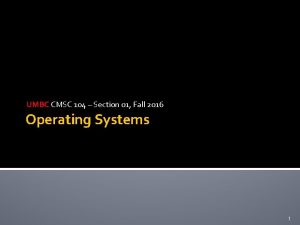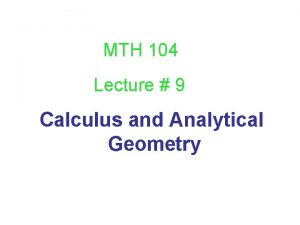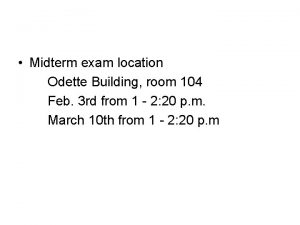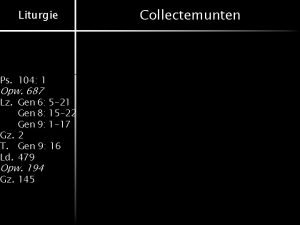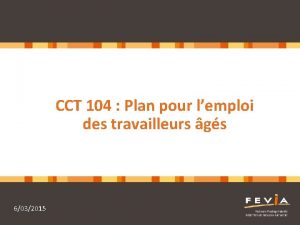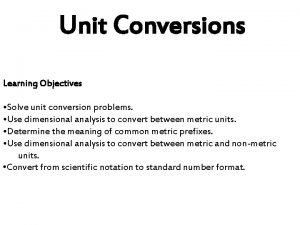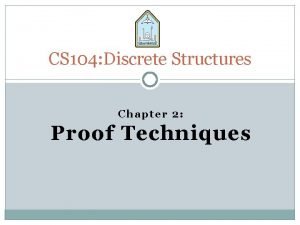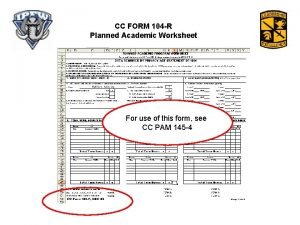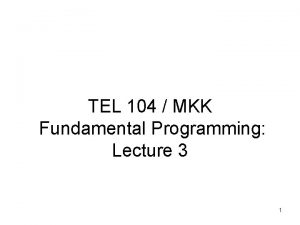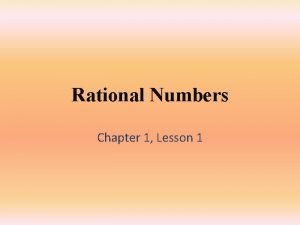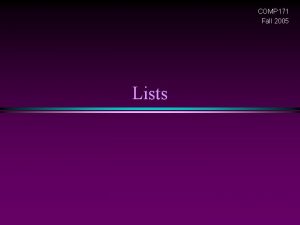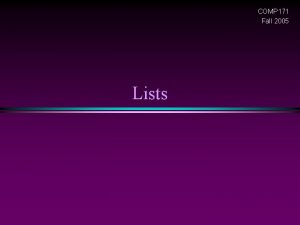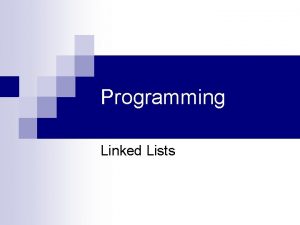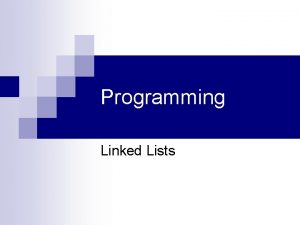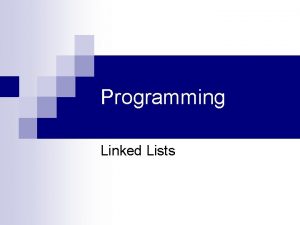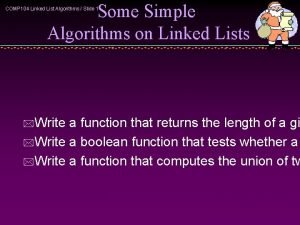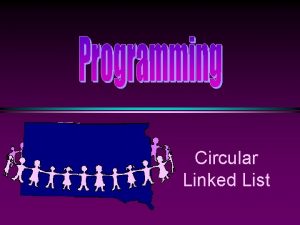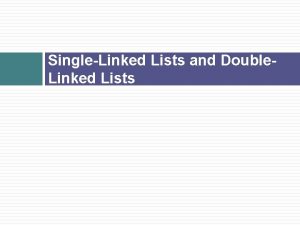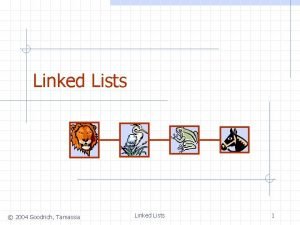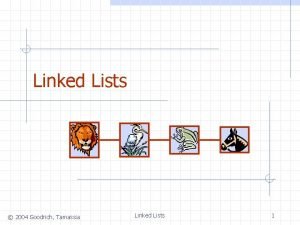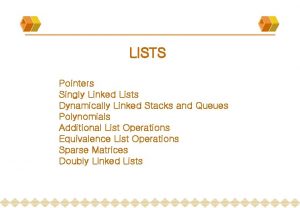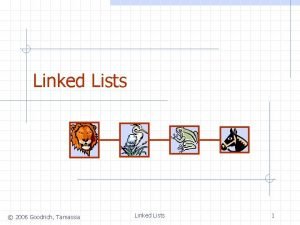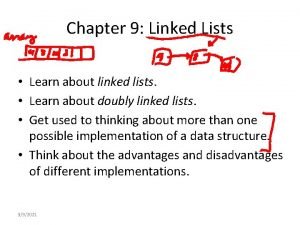Programming Linked Lists COMP 104 Linked Lists Slide































- Slides: 31

Programming Linked Lists

COMP 104 Linked Lists / Slide 2 Motivation * A “List” is a useful structure to hold a collection of data. n * Currently, we use arrays for lists Examples: List of ten students marks int student. Marks[10]; List of temperatures for the last two weeks double temperature[14];

COMP 104 Linked Lists / Slide 3 Motivation * list using static array int my. Array[10]; We have to decide in advance the size of the array (list) * list using dynamic array int n, *my. Array; cin >> n; my. Array = new int[n]; We allocate an array (list) of any specified size while the program is running * linked-list (dynamic size) size = ? ? The list is dynamic. It can grow and shrink to any size.

COMP 104 Linked Lists / Slide 4 Linked Lists: Basic Idea *A linked list is an ordered collection of data * Each element of the linked list has Some data n A link to the next element n * The link is used to chain the data * Example: A linked list of integers: Link Data 20 45 75 85

COMP 104 Linked Lists / Slide 5 Linked Lists: Basic Ideas * The 20 list can grow and shrink 45 add(75), add(85) 20 45 75 delete(85), delete(45), delete(20) 75 85

COMP 104 Linked Lists / Slide 6 Linked Lists: Operations * Original linked list of integers: 20 45 75 85 * Insertion: 20 old value 45 85 60 * Deletion 20 75 45 deleted item 75 85

#include <iostream> using namespace std; struct Node{ int data; Node *next; }; typedef Node* Node. Ptr;

COMP 104 Linked Lists / Slide 8 typedef * typedef allows you to make new shortcuts to existing types typedef int WAH; WAH k; // same as: int k; typedef int* WAHPTR; WAHPTR p; // same as: int *p; typedef Node* Node. Ptr; Node. Ptr Head; // same as: Node* Head;

COMP 104 Linked Lists / Slide 9 Linked List Structure * Node n : Data + Link Definition struct Node { int data; Node* next; }; n Create a Node* p; p = new Node; n //contains useful information //points to next element or NULL Delete a Node delete p; //points to newly allocated memory

COMP 104 Linked Lists / Slide 10 Linked List Structures n Access fields in a node (*p). data; //access the data field (*p). next; //access the pointer field Or it can be accessed this way p->data //access the data field p->next //access the pointer field

Representing and accessing Linked Lists COMP 104 Linked Lists / Slide 11 Head 20 * 45 75 85 We define a pointer Node. Ptr Head; that points to the first node of the linked list. When the linked list is empty then Head is NULL.

COMP 104 Linked Lists / Slide 12 Passing a Linked List to a Function * When passing a linked list to a function it should suffice to pass the value of Head. Using the value of Head the function can access the entire list. * Problem: If a function changes the beginning of a list by inserting or deleting a node, then Head will no longer point to the beginning of the list. * Solution: When passing Head always pass it by reference (or using a function to return a new pointer value) Head 20 45 75 85

COMP 104 Linked Lists / Slide 13 Manipulation of a Unsorted Linked List

COMP 104 Linked Lists / Slide 14 Start the first node from scratch Head = NULL; Head Node. Ptr new. Ptr; new. Ptr = new Node; new. Ptr->data = 20; new. Ptr->next = NULL; Head = new. Ptr; 20 Head new. Ptr

COMP 104 Linked Lists / Slide 15 Inserting a Node at the Beginning new. Ptr = new Node; new. Ptr->data = 13; new. Ptr->next = Head; Head = new. Ptr; 20 Head 13 new. Ptr

COMP 104 Linked Lists / Slide 16 Keep going … Head 50 new. Ptr 40 13 20

Adding an element to the head: void add. Head(Node. Ptr& Head, int newdata){ Node. Ptr new. Ptr = new Node; new. Ptr->data = newdata; new. Ptr->next = Head; Head = new. Ptr; }

COMP 104 Linked Lists / Slide 18 Deleting the Head Node. Ptr cur; cur = Head; Head = Head->next; delete cur; Head (to delete) 50 cur 40 13 20

void del. Head(Node. Ptr& Head){ if(Head != NULL){ Node. Ptr cur = Head; Head = Head->next; delete cur; } }

COMP 104 Linked Lists / Slide 20 Displaying a Linked List cur = Head; Head 20 45 cur = cur->next; Head 20 45 cur

COMP 104 Linked Lists / Slide 21 *A linked list is displayed by walking through its nodes one by one, and displaying their data fields. void Display. List(Node. Ptr Head){ Node. Ptr cur; cur = Head; while(cur != NULL){ cout << cur->data << endl; cur = cur->next; } }

Searching for a node //return the pointer of the node has data=item //return NULL if item does not exist Node. Ptr search. Node(Node. Ptr Head, int item){ Node. Ptr Cur = Head; Node. Ptr Result = NULL; while(Cur != NULL){ if(Cur->data == item) Result = Cur; Cur = Cur->next; } return Result; }

More operation: adding to the end COMP 104 Linked Lists / Slide 23 * Original linked list of integers: 50 * 40 13 20 Add to the end (insert at the end): 50 40 13 20 60 Last element The key is how to locate the last element or node of the list!

Add to the end: void add. End(Node. Ptr& Head, int newdata){ Node. Ptr last = Head; Node. Ptr new. Ptr = new Node; new. Ptr->data = newdata; new. Ptr->next = NULL; if(Head != NULL){ // non-empty list case while(last->next != NULL) last = last->next; last->next = new. Ptr; } else // deal with the case of empty list Head = new. Ptr; } Link new object to last->next Link a new object to empty list

COMP 104 Linked Lists / Slide 25 Manipulation of a Sorted Linked List

COMP 104 Linked Lists / Slide 26 Inserting a Node Head 20 prev 45 33 new. Ptr cur 75 . . .

COMP 104 Linked Lists / Slide 27 * To insert a new node into the list 1. (a) Create a new node using: Node. Ptr new. Ptr = new node; (b) Fill in the data field correctly. 2. Find “prev” and “cur” such that the new node should be inserted between *prev and *cur. 3. Connect the new node to the list by using: (a) new. Ptr->next = cur; (b) prev->next = new. Ptr;

COMP 104 Linked Lists / Slide 28 Finding prev and cur * Suppose that we want to insert or delete a node with data value new. Value. Then the following code successfully finds prev and cur. prev = NULL; cur = Head; while(cur!=NULL && prev = cur; cur = cur->next; } new. Value > cur->data){

//insert item into linked list in ascending order void insert. Node(Node. Ptr& Head, int item){ Node. Ptr New, Cur, Pre; New = new Node; New->data = item; Pre = NULL; Cur = Head; while(Cur != NULL && item > Cur->data){ Pre = Cur; Cur = Cur->next; } if(Pre == NULL){ //insert to head of linked list New->next = Head; Head = New; } else { Pre->next = New; New->next = Cur; } }

COMP 104 Linked Lists / Slide 30 Deleting a Node * To delete a node from the list 1. Locate the node to be deleted (a) cur points to the node. (b) prev points to its predecessor 2. Disconnect node from list using: prev->next = cur->next; 3. Return deleted node to system: delete cur; (to delete) Head 20 45 75 prev cur 85 . . .

Delete an element in a sorted linked list: void delete. Node(Node. Ptr& Head, int item){ Node. Ptr prev, cur = Head; while(cur!=NULL && item > cur->data){ prev = cur; cur = cur->next; } if(cur==NULL || cur->data!=item){ cout << "Delete error: " << item << " not in list!" << endl; return; } if(cur==Head) Head = Head->next; else prev->next = cur->next; delete cur; }
 Heel toe polka
Heel toe polka Advantage of linked list
Advantage of linked list Singly vs doubly linked list
Singly vs doubly linked list Apa itu single linked list
Apa itu single linked list Perbedaan linear programming dan integer programming
Perbedaan linear programming dan integer programming Greedy algorithm vs dynamic programming
Greedy algorithm vs dynamic programming Runtime programming
Runtime programming Integer programming vs linear programming
Integer programming vs linear programming Programing adalah
Programing adalah How to do slide and divide
How to do slide and divide Apple notes
Apple notes Programa 104
Programa 104 Lativ104
Lativ104 Calculus with analytic geometry examples
Calculus with analytic geometry examples Odette
Odette Who is this
Who is this Opw 687
Opw 687 Gg 104
Gg 104 Cct 104
Cct 104 Aphorism 83 to 104
Aphorism 83 to 104 Cao 104
Cao 104 Cao 104
Cao 104 Baby i'm foolish maybe i'm blind
Baby i'm foolish maybe i'm blind Csci 104
Csci 104 Michael tells sara he weighs 104 pounds
Michael tells sara he weighs 104 pounds I 102 104
I 102 104 Daily 104.com
Daily 104.com Cs 104
Cs 104 104-r planned academic worksheet
104-r planned academic worksheet Tel 104
Tel 104 Write the following rational number in decimal form. -104/5
Write the following rational number in decimal form. -104/5 Psalm 22 nbv
Psalm 22 nbv










